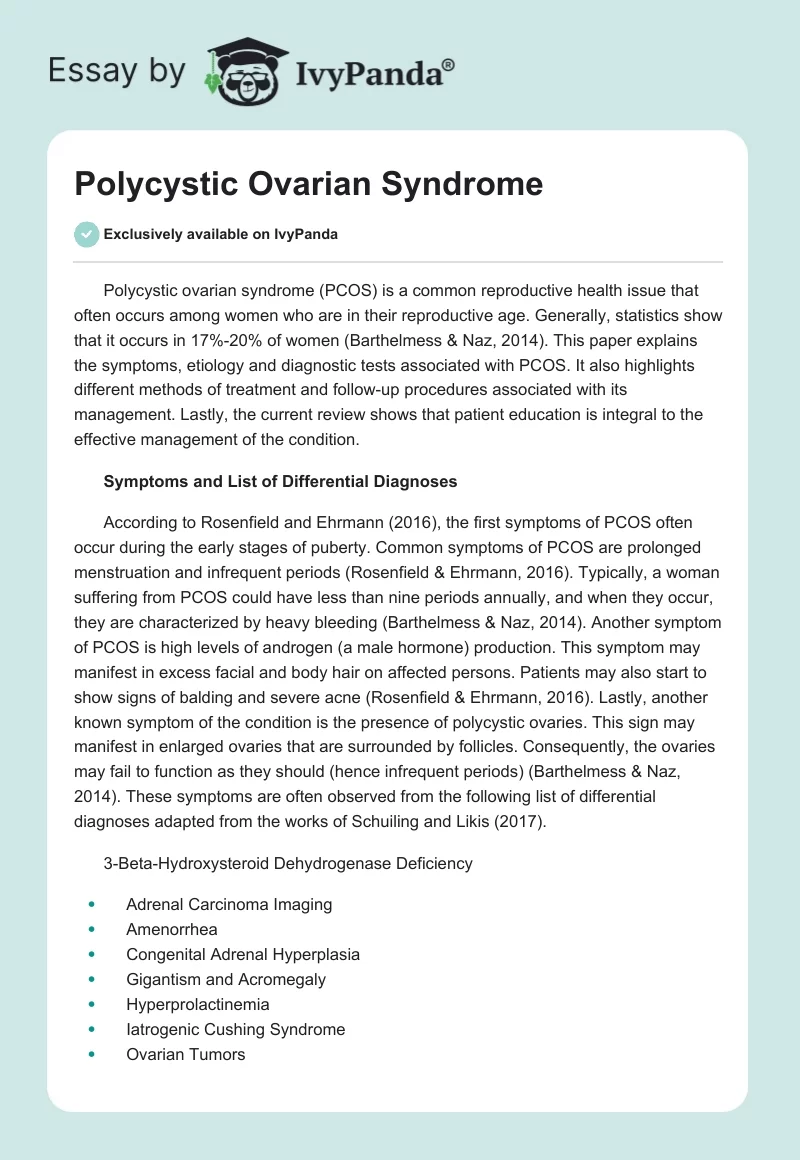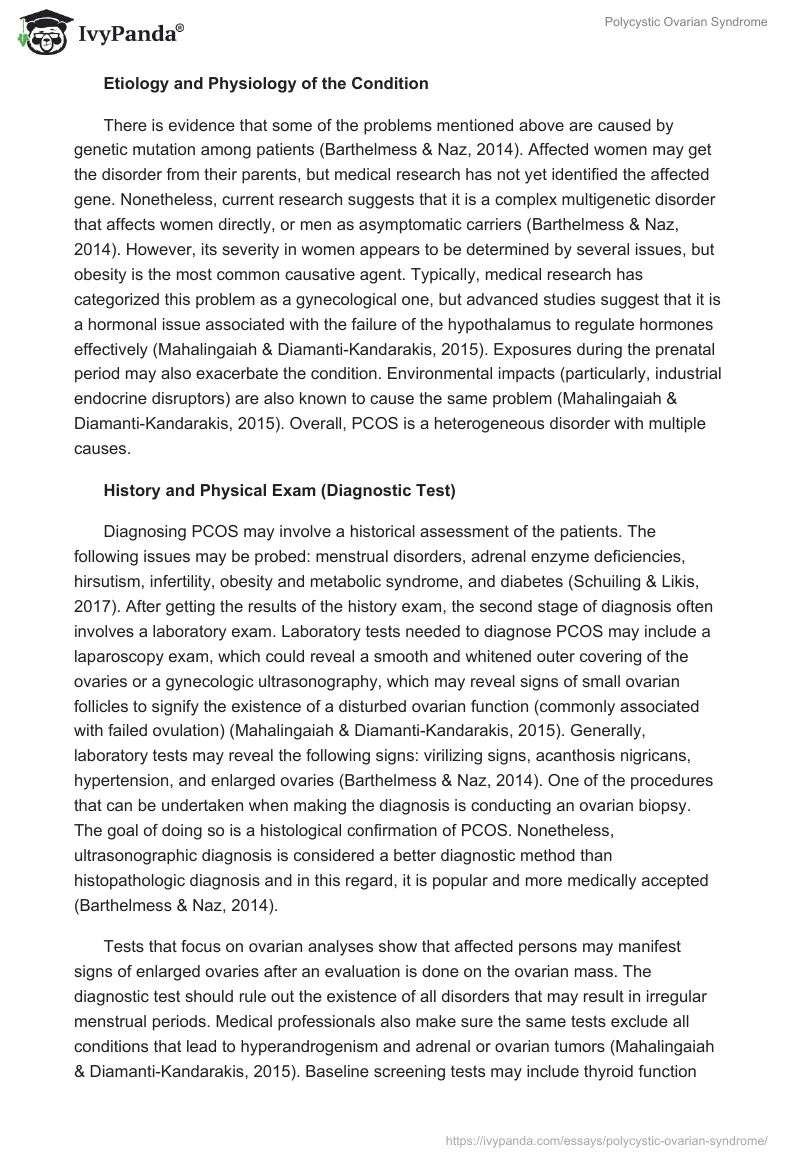Polycystic ovarian syndrome (PCOS) is a common reproductive health issue that often occurs among women who are in their reproductive age. Generally, statistics show that it occurs in 17%-20% of women (Barthelmess & Naz, 2014). This paper explains the symptoms, etiology and diagnostic tests associated with PCOS. It also highlights different methods of treatment and follow-up procedures associated with its management. Lastly, the current review shows that patient education is integral to the effective management of the condition.
Symptoms and List of Differential Diagnoses
According to Rosenfield and Ehrmann (2016), the first symptoms of PCOS often occur during the early stages of puberty. Common symptoms of PCOS are prolonged menstruation and infrequent periods (Rosenfield & Ehrmann, 2016). Typically, a woman suffering from PCOS could have less than nine periods annually, and when they occur, they are characterized by heavy bleeding (Barthelmess & Naz, 2014). Another symptom of PCOS is high levels of androgen (a male hormone) production. This symptom may manifest in excess facial and body hair on affected persons. Patients may also start to show signs of balding and severe acne (Rosenfield & Ehrmann, 2016). Lastly, another known symptom of the condition is the presence of polycystic ovaries. This sign may manifest in enlarged ovaries that are surrounded by follicles. Consequently, the ovaries may fail to function as they should (hence infrequent periods) (Barthelmess & Naz, 2014). These symptoms are often observed from the following list of differential diagnoses adapted from the works of Schuiling and Likis (2017).
3-Beta-Hydroxysteroid Dehydrogenase Deficiency
- Adrenal Carcinoma Imaging
- Amenorrhea
- Congenital Adrenal Hyperplasia
- Gigantism and Acromegaly
- Hyperprolactinemia
- Iatrogenic Cushing Syndrome
- Ovarian Tumors
Etiology and Physiology of the Condition
There is evidence that some of the problems mentioned above are caused by genetic mutation among patients (Barthelmess & Naz, 2014). Affected women may get the disorder from their parents, but medical research has not yet identified the affected gene. Nonetheless, current research suggests that it is a complex multigenetic disorder that affects women directly, or men as asymptomatic carriers (Barthelmess & Naz, 2014). However, its severity in women appears to be determined by several issues, but obesity is the most common causative agent. Typically, medical research has categorized this problem as a gynecological one, but advanced studies suggest that it is a hormonal issue associated with the failure of the hypothalamus to regulate hormones effectively (Mahalingaiah & Diamanti-Kandarakis, 2015). Exposures during the prenatal period may also exacerbate the condition. Environmental impacts (particularly, industrial endocrine disruptors) are also known to cause the same problem (Mahalingaiah & Diamanti-Kandarakis, 2015). Overall, PCOS is a heterogeneous disorder with multiple causes.
History and Physical Exam (Diagnostic Test)
Diagnosing PCOS may involve a historical assessment of the patients. The following issues may be probed: menstrual disorders, adrenal enzyme deficiencies, hirsutism, infertility, obesity and metabolic syndrome, and diabetes (Schuiling & Likis, 2017). After getting the results of the history exam, the second stage of diagnosis often involves a laboratory exam. Laboratory tests needed to diagnose PCOS may include a laparoscopy exam, which could reveal a smooth and whitened outer covering of the ovaries or a gynecologic ultrasonography, which may reveal signs of small ovarian follicles to signify the existence of a disturbed ovarian function (commonly associated with failed ovulation) (Mahalingaiah & Diamanti-Kandarakis, 2015). Generally, laboratory tests may reveal the following signs: virilizing signs, acanthosis nigricans, hypertension, and enlarged ovaries (Barthelmess & Naz, 2014). One of the procedures that can be undertaken when making the diagnosis is conducting an ovarian biopsy. The goal of doing so is a histological confirmation of PCOS. Nonetheless, ultrasonographic diagnosis is considered a better diagnostic method than histopathologic diagnosis and in this regard, it is popular and more medically accepted (Barthelmess & Naz, 2014).
Tests that focus on ovarian analyses show that affected persons may manifest signs of enlarged ovaries after an evaluation is done on the ovarian mass. The diagnostic test should rule out the existence of all disorders that may result in irregular menstrual periods. Medical professionals also make sure the same tests exclude all conditions that lead to hyperandrogenism and adrenal or ovarian tumors (Mahalingaiah & Diamanti-Kandarakis, 2015). Baseline screening tests may include thyroid function tests, serum prolactin tests, total and free testosterone tests. Other diagnostic procedures may involve a cosyntropin stimulation test, serum 17-hydroxyprogesterone, urinary free cortisol (UFC) test, low-dose dexamethasone suppression test, and serum insulin-like growth factor analyses (Mahalingaiah & Diamanti-Kandarakis, 2015). Imaging tests are also used to evaluate the presence of PCOS and they usually involve two tests: pelvic CT scan and ovarian ultrasonography. The latter test is preferably used in the transvaginal approach, while the pelvic CT scan test is used to visualize the adrenals and ovaries.
Treatment
The different options available to treat PCOS include pharmacotherapy and surgery. Pharmacotherapy is often recommended in cases where there are metabolic derangements. For example, PCOS cases that are characterized by anovulation, hirsutism, and menstrual irregularities are often treated using this method (Mahalingaiah & Diamanti-Kandarakis, 2015). The first type of therapy involved in this treatment is oral contraceptives to regularize menses. In cases where the symptoms do not go away, an androgen-blocking mechanism may be recommended. Similarly, when fertility is desired, letrozole or clomiphene citrates are often prescribed (Rosenfield & Ehrmann, 2016). Generally, some medications that may be used in the management of PCOS include oral contraceptives, antiandrogens, hypoglycemic, selective estrogen receptor modulators, topical hair-removal agents, and topical acne agents (Rosenfield & Ehrmann, 2016).
Metformin is a common drug used to treat the condition. The targeted dosage is 1500–2550 mg/day. Alternatively, this medicine could be administered in 500 or 850 mg dosages, three times daily (Palomba, Santagni, Falbo, & La Sala, 2015). Clinical responses associated with the drug are often reported when dosages are 1000 mg daily (Palomba et al., 2015). The main advantage associated with this treatment method is the induction of ovulation, but it is known to have limited efficacy in patients who have developed a drug resistance. Clomiphene Citrate (CC) is another line of pharmacological treatment for PCOS. Dosages of 50–150 mg are administered for five days. One of the main advantages of CC is that it is economical and easy to administer. Furthermore, there are few documented adverse effects associated with its use (Palomba et al., 2015). Similarly, users have reported the need for careful monitoring of patients (Palomba et al., 2015). One of the main disadvantages of this treatment method is its reduced efficacy among women who are in advanced ages (Palomba et al., 2015). Lastly, surgery is also another treatment method for PCOS, but its application is mostly limited to cases where there is a need to restore ovulation. Some laparoscopic methods used in this treatment process include electrocautery, laser drilling, and multiple biopsies. The main advantage of this treatment method is its efficacy in treating acute cases of PCOS and its low likelihood of causing multiple pregnancies. Comparatively, its main disadvantage is its invasive nature and the uncertainty regarding how long its effects would last (Schuiling & Likis, 2017).
Patient Education
Patient education is at the center of managing PCOS. Notably, patient education needs to help women to understand what PCOS is about, its possible signs, its causes, reasons for irregular periods, what happens during a regular cycle with PCOS, and the available treatments for the condition. Some resources that would help patients to understand these facts are available in the appendix section.
Evaluation and Follow-up
PCOS should be regularly evaluated because if left unchecked, it could lead to infertility (Palomba et al., 2015). According to Mahalingaiah and Diamanti-Kandarakis (2015), patients should be evaluated every three months to assess the efficacy of their treatment plans. The examination should also reveal whether they have suffered an adverse effect. If the examination reveals no such outcome, monitoring should be rescheduled to once every six months (Barthelmess & Naz, 2014). Combination therapies may be required to achieve high levels of success with the treatment.
Conclusion
This paper shows that PCOS is a common reproductive health problem affecting about 20% of women in their reproductive ages. The most common symptom is irregular menses. However, laboratory exams, such as laparoscopic tests and gynecologic ultrasonography are instrumental in making a diagnosis. The causes of PCOS are multifaceted. However, weight gain and genetics are largely associated with the condition. Patients who suffer from the condition could be treated using pharmacological means or surgical procedures. The evaluation and follow-up processes of these treatment methods should be done at least once every three months. Nonetheless, patient education is at the center of managing this condition because women should be taught how to live a healthy lifestyle. This is the most effective way of managing/preventing the condition.
References
Barthelmess, E. K., & Naz, R. K. (2014). Polycystic ovary syndrome: Current status and future perspective. Frontiers in Bioscience (Elite Edition), 6(1), 104-119.
Mahalingaiah, S., & Diamanti-Kandarakis, E. (2015). Targets to treat metabolic syndrome in polycystic ovary syndrome. Expert Opinion on Therapeutic Targets, 19(11), 1561-1574.
Palomba, S., Santagni, S., Falbo, A., & La Sala, G. B. (2015). Complications and challenges associated with polycystic ovary syndrome: current perspectives.
International Journal of Women’s Health, 7(1), 745-763.
Rosenfield, R. L., & Ehrmann, D. A. (2016). The pathogenesis of polycystic ovary syndrome (PCOS): The hypothesis of PCOS as functional ovarian hyperandrogenism revisited. Endocrine Reviews, 37(5), 467-520.
Schuiling, K. D., & Likis, L.E. (2017). Women’s gynecological health (3rd ed.). Massachusetts, CA: Jones & Bartlett.


